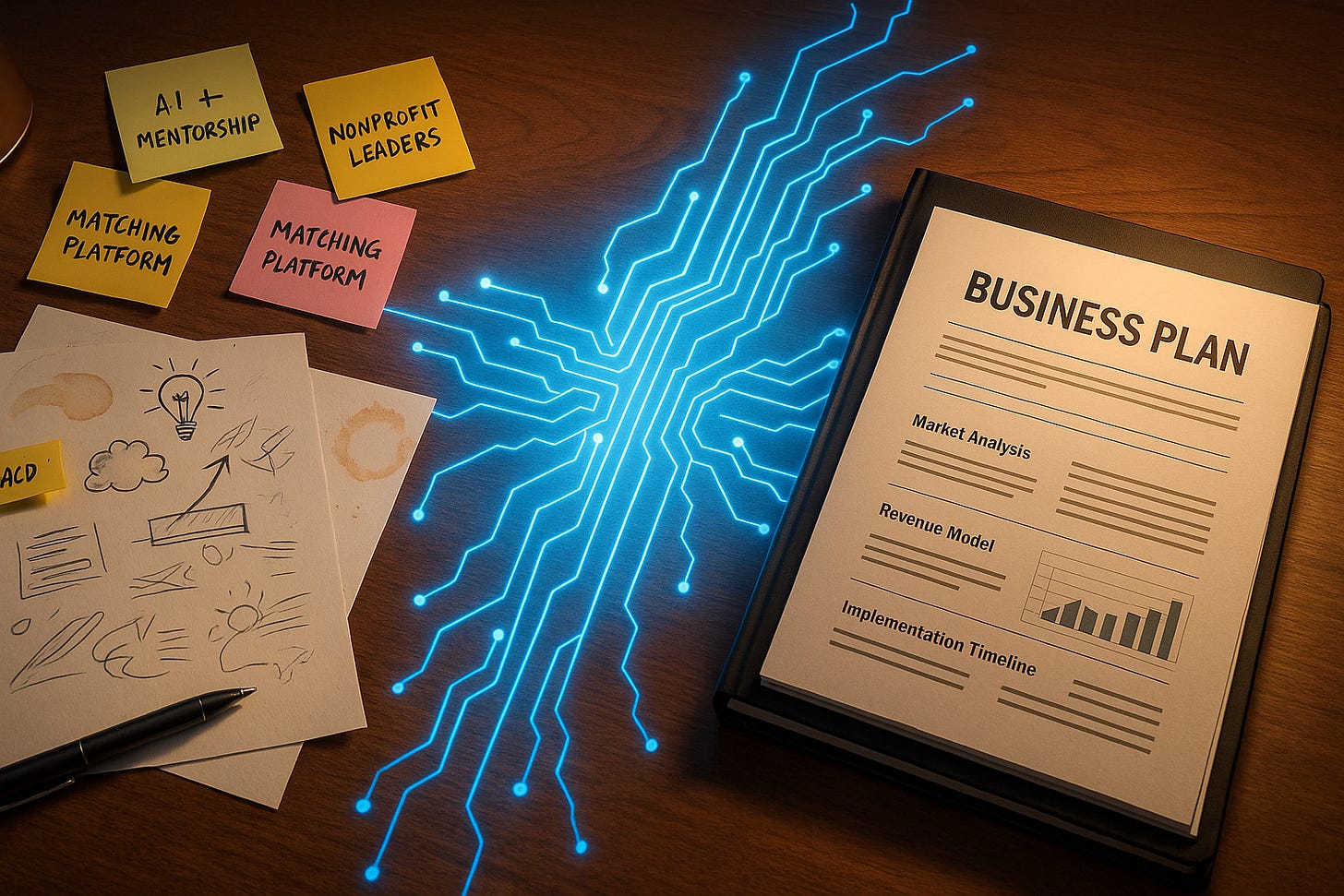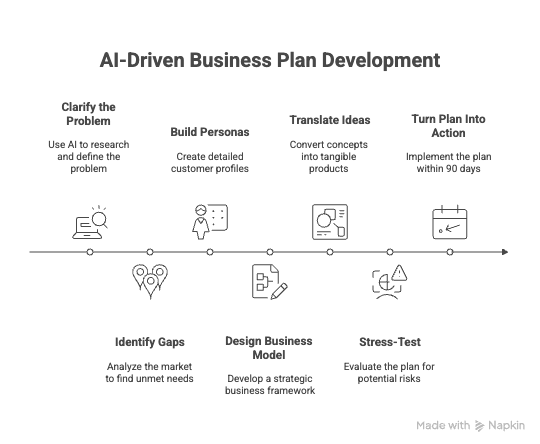7 Steps That Transform Any Idea Into a Launch-Ready Business Plan (Part 1 of 2)
From 3 AM Ideas to Strategic Insights (BRIDGE Method Part 1)
Thanks for reading! Join leaders worldwide who are future-proofing their leadership with Premium access to exclusive tools, direct guidance, and our leadership community. Discover what you're missing here with a free trial.
PS: Many subscribers get their Premium membership reimbursed through their company’s professional development $. Use this template to request yours.
Have you ever had one of those 3 AM moments where an idea hits you like lightning?
You grab your phone, frantically type notes that make perfect sense in the dark, then wake up to cryptic messages like "AI + coffee shops + community building = ??"
I've been there. Last month, I had three separate conversations with friends and leaders who all said the same thing: "I know we need to innovate, but I have no idea how to go from brainstorm to business plan." They had energy, they had vision, but they were stuck in that frustrating valley between inspiration and action.
I realized we needed to flip the script entirely. Instead of more brainstorming sessions, leaders need a systematic way to develop ideas. I've used an AI process to do this and to develop a startup concept I'm launching this year, and now I want to share my process with you.
This isn't another AI productivity hack. This is how you use AI to think more strategically about innovation.
Let me walk you through exactly what happened when I took a messy 3 AM idea and turned it into a complete business plan in two weeks using what I call the BRIDGE Method:
Brainstorm → Research → Identify → Design → Generate → Execute
Case Study: MentorMatch for Nonprofit Leaders
To carry us through each step, we'll use this fictional innovative idea: "What if there was a way to connect experienced nonprofit leaders with newer leaders who need guidance, but make it actually work unlike existing mentorship programs?"
As we go through this, think through how your idea would fit into each step.
Step 1: Here's How I Get Claude to Cut Through the Noise (Brainstorm → Research)
Why This Step Matters for Leaders: Most leaders waste months validating problems that don't actually exist. They assume they understand their market because they live in it, but assumptions kill innovation faster than bad execution. This step forces you to separate what you think you know from what actually exists in the data.
How to Apply This: Use Claude to research the problem space systematically, not just confirm your hunches. Ask for specific data, failure patterns, and root causes. Don't just research the obvious; dig into why existing solutions fail. This reveals opportunities everyone else misses.
The key is asking Claude to challenge your assumptions, not validate them. Most leaders unknowingly use AI to confirm their biases (more on that, here). Smart leaders use it to expose their blind spots.
Prompt:
Research the current state of mentorship in the [YOUR INDUSTRY/SECTOR] sector. What are the main challenges new [YOUR TARGET AUDIENCE] leaders face? What mentorship solutions exist and why do they typically fail? Provide specific data on [YOUR INDUSTRY] leadership turnover and development needs.Applied to MentorMatch:
Example using nonprofit sector: "Research the current state of mentorship in the nonprofit sector. What are the main challenges new nonprofit leaders face? What mentorship solutions exist and why do they typically fail? Provide specific data on nonprofit leadership turnover and development needs."
Here's what shocked me: The AI research revealed that 80% of nonprofit mentorship programs fail because they solve the wrong problem entirely. I thought it was about connecting people. Turns out, it's about structure.
Step 2: How I Map Competition Without Drowning in Analysis (Research → Identify)
Why This Step Matters for Leaders: Most competitive analysis is either too shallow (quick Google search) or too deep (analysis paralysis). Leaders either skip this entirely or spend months researching competitors without gaining actionable insights. This step gives you strategic intelligence, not information overload.
How to Apply This: Don't just map who your competitors are; understand why they exist and where they fall short. Use Claude to identify patterns across the competitive landscape. Focus on gaps, not features. Ask what problems remain unsolved, what customer segments are underserved, and what approaches haven't been tried.
The goal isn't to beat competitors at their own game. It's to find the game they're not playing.
💡 Copy-Paste Competitive Research Prompt:
Analyze existing [YOUR INDUSTRY] platforms, [YOUR SOLUTION TYPE] programs, and [RELEVANT SERVICE] services. Create a comprehensive competitive analysis that includes:
Competitor Overview: Main players, market positioning, and business models
Feature Comparison: What they offer, pricing structures, and target audiences
SWOT Analysis: Strengths, weaknesses, opportunities, and threats for each major competitor
Market Gaps: Focus specifically on what's NOT being addressed by current solutions
Underserved Segments: What customer groups or use cases are being ignored
Differentiation Opportunities: Where can a new solution create unique value
Provide specific data on market size and growth trends. Focus on actionable insights, not just feature lists.Applied to MentorMatch: "Analyze existing nonprofit mentorship platforms, leadership development programs, and matching services. Create a comprehensive competitive analysis that includes competitor overview, feature comparison, SWOT analysis, market gaps, underserved segments, and differentiation opportunities. Focus specifically on what's NOT being addressed by current solutions."
Discovery:
Market size: 1.8 million nonprofit organizations in the US
SWOT revealed: Competitors are strong on matching, weak on structured outcomes
The gap: No platform designed specifically for nonprofit leadership with structured 90-day sprint programs
My differentiation strategy: Focus on outcome-based mentorship sprints, not endless coffee chats.
Step 3: I Built Personas That Actually Matter (Identify → Design)
Why This Step Matters for Leaders: Generic personas are worthless. Most leaders create demographic profiles instead of psychographic insights. They know their customers' ages and incomes, but not their fears and motivations. This step creates personas you can actually design solutions for.
How to Apply This: Use Claude to build personas based on behavioral patterns, not demographic data. Focus on specific frustrations, time constraints, success definitions, and decision-making processes. Ask for direct quotes that capture their mindset. These personas should feel like real people you could have coffee with, not market segments you're targeting.
The test: Can you predict how each persona would react to your solution before you build it?
💡 Copy-Paste Persona Research Prompt:
Based on [YOUR INDUSTRY] research, create detailed personas for [YOUR PRIMARY USER TYPES]. For each persona, include:
Specific quotes about their frustrations, challenges, and pain points
Time constraints and how they make decisions
Success definitions - what does winning look like to them?
Behavioral patterns - how do they currently solve these problems?
Emotional drivers - what motivates them beyond practical needs?
Technology comfort level and communication preferences
Make these feel like real people I could have coffee with, not demographic profiles. Include direct quotes that capture their mindset.Applied to MentorMatch: "Based on nonprofit leadership research, create detailed personas for both mentors (experienced nonprofit leaders) and mentees (newer leaders). Include specific quotes about their frustrations, time constraints, and what success looks like to them."
The personas that emerged:
Sarah the Struggling Director: "I inherited this role and I'm drowning in fundraising requirements I never learned."
Michael the Seasoned CEO: "I want to help, but I need something structured. I can't just wing it on weekly calls."
These weren't demographic profiles. These were real people with real problems I could solve.
What We've Accomplished So Far
In just three steps, we've transformed a messy 3 AM idea into strategic intelligence:
Research revealed the real problem (structure, not connection)
Competitive analysis identified the gap everyone missed (outcome-based sprints)
Personas gave us real people to design solutions for
But here's where most leaders stop. They have great insights but struggle to turn understanding into buildable solutions. That's exactly what we'll tackle in Part 2.
Coming in Part 2: From Insights to Launch-Ready Business Plan
In Part 2 of this series, I'll show you how to complete the BRIDGE Method by transforming these strategic insights into:
A sustainable business model with clear revenue streams
Technical specifications detailed enough for developers to build
Risk mitigation strategies to avoid predictable failures
A 90-day implementation roadmap with weekly milestones
I'm curious: What's the one idea you've been carrying around that could change everything if you could just figure out how to make it real? Hit reply and tell me about it—I read every response.
Let’s Connect
I love connecting with people. Please use the following connect, collaborate, if you have an idea, or just want to engage further:





The biggest challenge I see: people want the prompts, but don’t want to understand the why behind them. They want to copy & paste, but don’t want to read the response. A little diligence goes a long way to learn the playbook and run it yourself. Thanks for the share!
Love it...
thanks for the prompts.